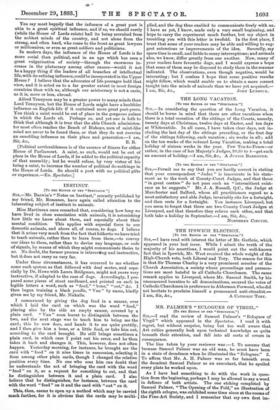MR. PALMER'S " ECLOGUES OF VIRGIL." [To THE EDITOR 07
THE "SPECTATOR."] SIR, I read the review of Samuel Palmer's " Eclogues of Virgil" which appeared in the Spectator. I read it with regret, but without surprise, being but too well aware that Art critics generally look upon technical knowledge as quits beneath their attention, and fall into all sorts of errors in consequence.
The line taken by your reviewer was :-1. To assume that because Samuel Palmer was an old man, he must have been in a state of decadence when he illustrated the " Eclogues." 2. To affirm that Mr. A. H. Palmer was so far beneath even the decadent Samuel Palmer as an executant, that he spoiled every plate he worked upon.
As I have had something to do with the work in ques- tion from the beginning, perhaps I may be allowed to say a word in defence of both artists. The one etching completed by Samuel Palmer, " The Opening of the Fold," an illustration of the eighth eclogue, was exhibited some time since at the rooms of the Fine-Art Society, and I remember that my own first im-
pression on seeing it there was wonder that a man of Palmer's age should have been able to execute such a piece of work. To say that there is no trace of decadence in that plate would be true, but not enough. That plate is the perfect consummation -of Palmer's experience, knowledge, and manual power. A fine proof of it is the high-water mark of that particular kind of etching. Much more might be said about it, if I went into detail, but I shall do that in another periodical. Your reviewer seems to have thought that because Palmer was an old man, it was safe to say that he was in a state of decadence. He was not in a state of decadence, nor am I blinded whilst saying this by my deep respect for the man, or alone in this opinion. Skilful artists acknowledged his greater skill, and if critics had possessed even a very little of his knowledge, they would have been better able to distinguish between one kind of art and another.
With regard to the work done by Mr. A. H. Palmer, let me say, as one writing with a clear knowledge of the technical diffi- culties he had to contend against, that I have been surprised not by the loving care and the inexhaustible patience that his filial duty lavished on what he knew to be thankless and un- appreciated toil, but by the success that rewarded it. His share in the work is, at the same time, absolutely subordinated in method and successful in result. As an example of this careful subordination in method, I have only to mention the second illustration in which your reviewer is unable to trace Mr. A. H. Palmer's hand, yet he worked three weeks upon that heliogravare. I remember being delighted with what he had done when the proof was sent me, and it seemed to the publishers and myself that his success opened a new field in book illustration, since what was objectionable in heliogravare could be so completely corrected, whilst at the same time it afforded a most useful basis to work upon.
That plate more nearly resembles a mezzotint than an etching, but in the pure etchings which Mr. A. H. Palmer has com- pleted, his work is so good, that it is impossible to say for cer- tain exactly what has been done by him to each plate. I have a thorough knowledge of the technical peculiarities of Samuel Palmer's work, and yet it would be mere guessing if I tried to point out what the son has added. If the reader will look at "The Opening of the Fold" (eighth eclogue), which was un- touched by the son, and afterwards at such plates as those illustrating the lines,— "Ripe apples are our supper, cream unstirred," and,—
" Untimely lost, and by a cruel death,"
he will find it impossible to separate the son's work from the father's, so completely has Mr. A. H. Palmer assimilated not only his father's feeling and spirit, but even the quality of his handicraft. Indeed, your reviewer himself is in this position also, for he attributed the cross-hatching in the sky of "The Opening of the Fold" to Mr. A. H. Palmer, whereas it was the work of his father, and some of his best work.
Your reviewer complains that "there are so many different kinds of photographic processes which superficially resemble woodcuts and etchings." They cannot resemble woodcuts and etchings at the same time, but perhaps that is not what the writer intended to say. As for those processes that may really really resemble etchings, there are, in principle, only two,—one in which the copper-plate is grown by electrotyping with all the depressions in it, and the other in which the depressions are bitten in a plate already provided. Both allow of subsequent work on the plate, and the best result is obtained by the alliance of photographic reproduction with artistic skill and knowledge. This occurs when the plate, after being carried as far as mechanical processes will go, is taken in hand for correction by so intelligent an artist as Mr. A. H. Palmer.—I am, Sir, Sce.,
P. G. HAsxRToN,
Author of "Etching and Etchers," "The Graphic Arts," &c.



































 Previous page
Previous page